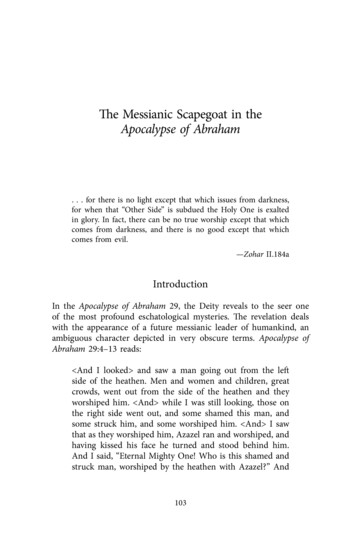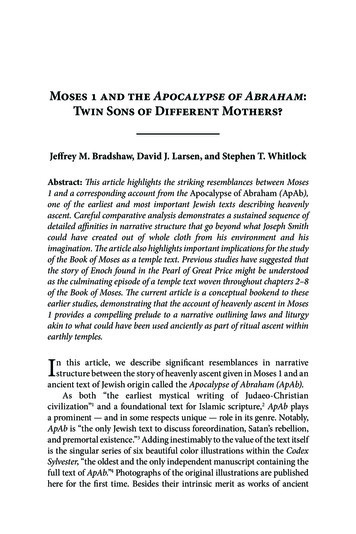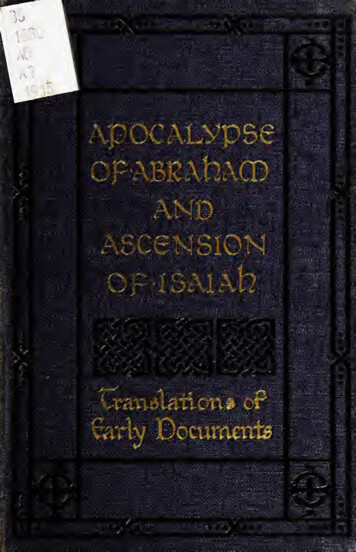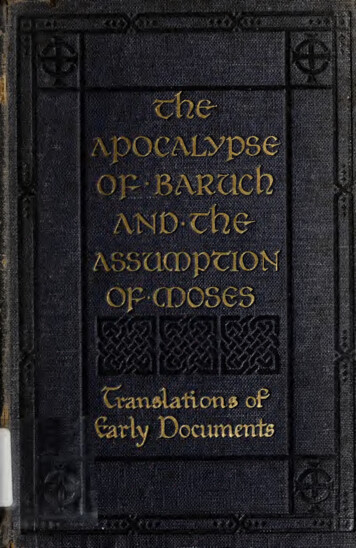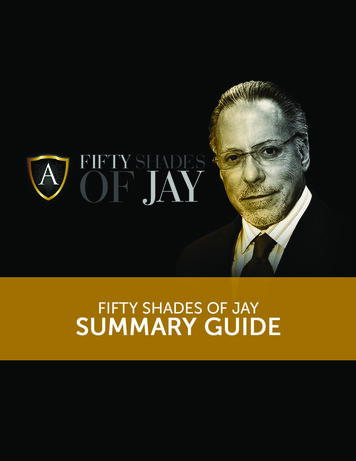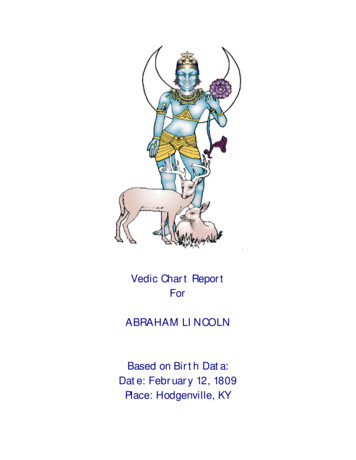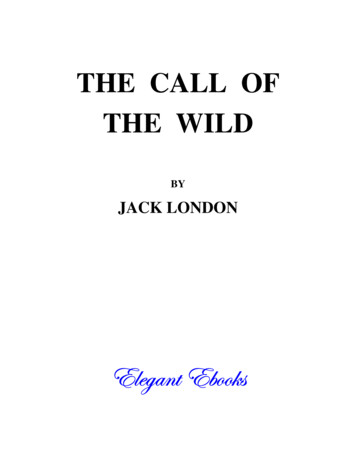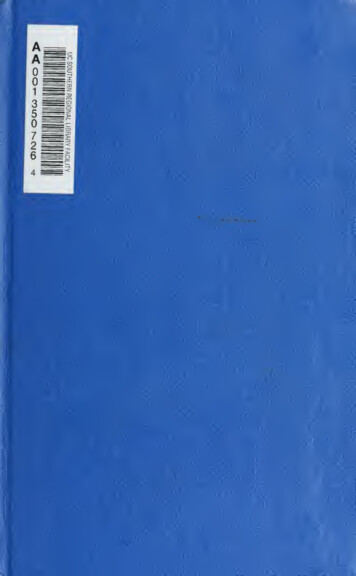
Transcription
A
m\ ' JliDNV-SOV '
jo ojnv jo 'aOFCAIIFO%'' mmu v :lOSANCElfj .[IRDADV/l .viT:.IIRRADV/i ai'31 !/ojnvjjO'"3%ii-2? ;;OfCALIF0/?4A4n:' .Z)ll JNa-3WV'
TRANSLATIONS OF EARLY DOCUMENTSSERIESIPALESTINIAN JEWISH TEXTS(PRE-RABBINIC)THE APOCALYPSE OFABRAHAM
THE APOCALYPSEOF ABRAHAMEDITED, WITH A TRANSLATION FROM THE SLAVONICTEXT AND NOTESBYG.LECTURERH.BOX, M.A.HEBREW, KINg's COLLEGE, LONDONHON. CANON OF ST. ALBANSIN KABIilNIC;WITH THE ASSISTANCE OFJ.I.LANDSMANSOCIETY FOR PROMOTINGCHRISTIAN KNOWLEDGELONDON: 68, HAYMARKET, S.W.NEW YORK: THE MACMILLAN COMPANYi.1919
First Edition 19 1 8.Second Impression1919.
EDITORS' PREFACETheobject of this series of translations is primarilyfurnish students with short, cheap, and handytext-books, which, it is hoped, will facilitate thestudy of the particular texts in class under competent teachers. But it is also hoped that thevolumes will be acceptable to the general readerwho may be interested in the subjects with whichIt has been thought advisable, as athey deal.general rule, to restrict the notes and comments toa small compass; more especially as, in most cases,excellent works of a more elaborate character areIndeed, it is much to be desired thatavailable.these translations may have the effect of inducingreaders to study the larger works.Our principal aim, in a word, is to make somedifficult texts, important for the study of Christianorigins, more generally accessible in faithful andscholarly translations.In most cases these texts are not available in acheap and handy form. In one or two cases textshave been included of books which are availablebut in every such casein the oflicial Apocryphareasons exist for putting forth these texts in a newtranslation, with an Introduction, in this series.to;9):He ): l H An edition of The Apocalypse of Abraham is included in the present volume. The explanatorynotes, in this case, given in the commentary on ther f rf * Cr*
PREFACEvitext, are rather longer and fuller than usual.Thiswas rendered necessary by the fact that the Book ismadefirstaccessibletime;hereand thetoEnglish readersdifficultiesforand obscuritiesthein thetext are not inconsiderable.W.G.O. E. Oesterley.II.Box.
INTRODUCTIONShort Account of the BookThe Apocalypse oj Abraham, which has beenpreserved in old Slavonic literature, falls into twodistinct parts (cf. the somewhat similar case of TheAscension of Isaiah). The first part, contained inchaps, i.-viii., consists of a Midrashic narrativebased upon the legend of Abraham's conversionfrom idolatry, which has several peculiar features.The second part (chaps, ix.-xxxii.) is purelyapocalyptic in character, and contains a revelationmade to Abraham about the future of his race, afterhis (temporary) ascent into the heavenly regions,under the guidance of the archangel Jaoel, who hereseems to play the part of Metatron-Michael. It isbased upon the account of Abraham's trance-visiondescribed in Genesis xv. a favourite theme forapocalyptic speculation. In the Book, as it lies beforeus, the two parts are organically connected.Thus/ am the one wJioin chap. x. the archangel sayswas commissioned to set on fire thy father's housetogether with him, because he displayed reverence fordead {idols) an allusion to the narrative of chap. viii.and the general plan of the whole work seems to bebased upon the idea that Abraham's dissatisfactionwith the idol- worship by which he was surrounded,which found vent in his strong protest to his fatherTerah (chaps, i.-viii.), appealed so much to the divinefavour, that the archangel Jaoel was specially sent—:—*See AppendixviiI,esp. p. 93.
INTRODUCTIONviiiby Godto instruct himof heavenlyandinitiate liini into themysteries. Whether theapocalyptic portion ever existed in a shorter andindependent form will be discussed below.The Book opens with a description of Abraham'sactivities as a maker and seller of idols, his fatherknowledgeTerah being a manufacturer ofidols.His doubtsas to the justifiable character of the idol- worship areroused especially by an accident that befell the stoneimage called Merumath, and by a similar accident thathappened to " five other gods," by which they werebroken in pieces (chaps, i.-ii.). Reflecting on this, heis led to protest to his father against the unreaHtyof asking a blessing from such helpless images, therebyrousing Terah's anger (chaps, iii.-iv.). He is led totest further the powers of the idols by placing awooden god Barisat before the fire, and telling theidol to see that the fire must not be allowed to diedown during his absence. On returning he iinds Barisatfallen backwards and " horribly burnt " (chap. v.).He again protests to his father against the futility ofsuch worship, sarcastically contrasting the relativemerits of gold, silver and wooden idols (chap. vi.).He then proceeds to show that the elements of fire,water, earth, and the heavenly bodies (sun, moon,and stars) are more worthy of honour than the idols,and yet, as each is subjected to some superior force,they can none of them claim to be God (chap. vii.).While he was yet speaking to his father a voice camefrom heaven bidding him leave his father's house.He had scarcely left the house when fire descendedand consumed all within it.The apocalyptic part opens with a divine commandto Abraham to prepare a sacrifice with a view toreceiving a divine revelation concerning the futureAbraham, terrified at the experience, is(chap. ix.).who encourages him,commission to be with Abraham, andconfronted by the angel Jaoel,and explainshisUnder the direction of theact as his celestial guide.angel he proceeds to Horeb, the ]\Iount of God, a
INTRODUCTIONixjourney of forty days (chaps, x.-xii.), and there, withthe help of Jaoel, accomphshes the sacrifice. At thispoint Azazel, the fallen archangel and seducer of mankind, intervenes and attempts to dissuade Abrahamfrom his purpose. In the form of an unclean bird hefiles down "upon the carcasses" (cf. Gen. xv. ii),and tries to induce Abraham to leave the holy place,but in vain. Jaoel denounces the evil spirit, biddinghim depart, and telling him that the heavenlygarment which was formerly his has been set asideforAbraham(chaps, xiii.-xiv.).After this Abraham and the angel ascend on thewings of the unslaughtered birds (of the sacrifice)It is filledto heaven, which is described at length.with " a strong light " of power inexpressible, andthere they see the angels who are born and disappeardaily, after singing their hymn of praise (chaps, xv.xvi.).At this point Abraham, hearing the divinevoice, falls prostrate, and, taught by the angel, uttersthe celestial song of praise, and prays for enhghtenment (chap. xvii.). He sees the divine throne withthe Cherubim and the holy Creatures {Jiayyoth), ofwhom a description is given, and particularly of theirrivalry which is mitigated by the activity of Jaoel(chap, xviii.).God now speaks and discloses toAbraham the powers of heaven in the various firmaments below (chap. xix.). God promises him a seednumerous as the stars (chap. xx.). In answer to aquestion by Abraham about Azazel, God shows hima vision of the world, its fruits and creatures, thesea and its monsters (including Leviathan), theGarden of Eden, its fruits, streams, and blessedness.He sees also a multitude of human beings " half ofthem on the right side of the picture, and half ofthem on the left " (chap. xxi.). The fall of man isexplained to him, being traced to the sin of Adamand Eve in the Garden, a vision of which appearsin the picture and also of its results upon the destiniesof mankind, who are divided into the people on theright side of the picture, representing the Jewish
INTRODUCTIONXworld, and the people on the left representing theheathen world. In particular the sin of idolatryresulting in impurity and murder is sketched andmade manifest (chaps, xxii.-xxv.). The question,why sin is permitted, is answered by God (chap, xxvi.),and this is followed by a vision of judgement in whichthe destruction of the Temple is pourtrayed. Inanswer to Abraham's anguished question it is explained to him that this is due to the sin of idolatryon the part of his seed. At the same time a hint isgiven him of coming salvation (chap, xxvii.). Inanswer to the question, how long shall the judgementlast ? a description is given of the troubles precedingthe Messianic Age, and the dawn of the latter (chaps,xxviii.-xxix. ; the latter chapter contains a longChristian interpolation).At this point Abraham hndshimself " upon the earth," but receives a furtherdisclosure regarding the punishment of the heathenand the ingathering of Israel (chaps, xxx.-xxxi.).short paragraph repeating the promise of thechosen people's deliverance from oppression closesthe Book (chap, xxxii.).The character of the I3ook, as a whole, is thoroughlyIts original language was probably HebrewJewish.or Aramaic, from which a Greek version (underlyingthe Slavonic) was made and the date of the originalcomposition may be placed at the end of the firstor the beginning of the second century a.d.A;The Slavonic Text and MSSThe Slavonicversion,orrather translation,ofThe Apocalypse of Abraham {Ap. Abr.) has beenpreserved in a number of MSS. The oldest andmost valuable of these is the famous Codex, Sylvester, The substanceof this section of the Introduction hasbeen contributed by Mr.J. I.Landsman.Sylvester, after whom the MS. is named, was a prominentpriest in the early years of the reign of Ivan the Terrible,
INTRODUCTIONxiwhich now belongs to the Library of the Printingdepartment of the Holy Synod in Moscow. TheI\1S., which dates from the first half of the fourteenthcentury, is written on parchment, with two columnson each page, and contains 216 leaves in all, ourApocalypse occupying leaves 164-182. It contains a collection of lives of different saints, and TheApocalypse of Abrahain stands in it as a work complete in itself, without any connexion with the workswhich precede and follow it.The text of our Apocalypse according to CodexSylvester (cited as S) has been edited by ProfessorN. Tikhonravov in his Memorials of Russian Apocryphal Literature {Pamyatniki otrechennoi russkoi literatury), IMoscow, 1863, Vol. I. pp. 32-53; and alsoProfessor J. Sreznevsky in his Ancient Monuments opRussian Writing and Language {Drevnie Pam'yatnikirnsskovo pis' ma i yazyka), Petrograd, 1863, I. pp.247'-256% with readings from the Uvaroff MS.,which apparently is a mere copy of S. Tikhonravovhas supphed his edition with corrections of thenumerous clerical mistakes which abound in S,thereby earning the gratitude of students, whileSreznevsky has satisfied hiniself with producing amere copy of the text, with all its mistakes. Apartfrom these editions there has also been publishedby the Imperial Society of Bibliophiles a facsimileedition of the text of our Apocalypse, according toS (Petrograd, i8go), thus affording students the meansof consulting the MS. itself.Apart from S theupon whom he for some years exercised a sahitary influence.He was an author and lover of books, and the Codex wasone of a coHcction of MSS. which remained after his deathin the Kirillo monastery, whither he was banishedseeSreznevsky, Narratives about the Saints Boris and Gleb:{Skazaniasv'yaiykh BoriseiGlebe), Petrograd, i860, Pt.I.,and The Orthodox Encyclopa;dia [Pravoslavnaya BogoslovskayaE.) iv. pp.A1195 {s.v. Domostroi).description of Sfulli-viii.isgiven by Sreznevsky, op.cit.,
INTRODUCTIONxiitext of Ap. Ahr. is also contained in many Palccas}Palffia, as its name indicates (r/ TraA-ota sc. ZuxdyK-q),deals with the Old Testament, especially with thehistorical part of it, beginning with creation andending with David or Solomon, the biblical narrativesThebeing enlarged and embellished with apocryphal andpseudepigraphical matter. The origin of the SlavonicPalaia must be sought in some Greek prototype, which by way of Bulgaria and Serbia had, at an earlydate, found an entrance into Russia, where forcenturies it enjoyed great popularity at least solong as a translation of the whole Bible had notbeen made accessible to both clergy and people, thatis up till the sixteenth century.There are two kinds of Palieas, the historicaland the expository, the former being also knownas the " eyes " of the Palsea, because it contains thetext upon which the expository Palaja comments.The expositions are of a polemical character, thepolemic being invariably directed against the Jews{Zhidovin), to whom it is demonstrated that all theprophecies and the manifold types had found their—true fulfilment in Christ. The Pala:a draws richlyupon the Jewish Midrashic Literature, and then usesthe material as an argument against the Jews fromwhom it was borrowed.Originally our Apocalypse had no place in thePalffia, as may be seen from the oldest Pakea MS.,which dates from the fourteenth century, and isinthe Alexander-Nevsky MonasteryLater, it was inserted, but still retained(Petrograd).its original character of an independent work (asis the case in the Uvaroff Patea) ; but later stillpreserved1 On the subject of the Patea see the works of N. S.Tikhonravov {Sochiyienia), Mosco-w, 1898, Vol. I. pp. 15C-170,and the vahiable notes at the end of the volume cf. alsothe article Palcsa in the Russian Encyclopaedia published byBrockhaus Efron. A MS. of a Greek Palasa is known to exist in the ViennaLibrary, and has been edited by A. V. Vasil'eff in Anecdota;—graco-byzaiitina,I.pp. 188-192 (Moscow, 1892).
INTRODUCTIONxiii(from the sixteenth century and onwards) the textAp. Ahr. loses its original character of an independent work, the material being worked into thelife of Abraham.Tlie title of the Book is dropped,and the first person in which Abraham speaks in S isaltered into the third, that is, it is changed into a narrative about Abraham, though the scribe often forgetshimself and retains the first person of the original.The apocryphal and pseudepigraphical writingsmust have been introduced i
TheApocalypseojAbraham,whichhasbeen preservedinoldSlavonicliterature,fallsintotwo distinctparts(cf.thesomewhatsimilarcaseofThe AscensionofIsaiah).Thefirstpart,containedin chaps,i.-viii.,consistsofaMidrashicnarrative baseduponthelegendofAbraham'sconversion fromidolatry,whichhasseveralpeculiarfeatures. Thesecondpart(chaps,ix.-xxxii.)ispurely
